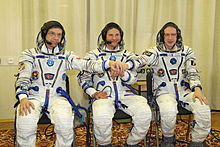Soyuz TMA-15
| Mission type | ISS crew rotation |
|---|---|
| Operator | Roskosmos |
| COSPAR ID | 2009-030A |
| SATCAT no. | 35010 |
| Mission duration | 188 days |
| Spacecraft properties | |
| Spacecraft type | Soyuz-TMA 11F732 |
| Manufacturer | RKK Energia |
| Crew | |
| Crew size | 3 |
| Members |
Roman Romanenko Frank De Winne Robert Thirsk |
| Callsign | Таймыр (Taymyr) or Парус (Parus, meaning Sail) |
| Start of mission | |
| Launch date | 27 May 2009, 10:34:53 UTC |
| Rocket | Soyuz-FG |
| Launch site | Baikonur 1/5 |
| End of mission | |
| Landing date | December 1, 2009, 07:17 UTC |
| Orbital parameters | |
| Reference system | Geocentric |
| Regime | Low Earth |
| Perigee | 151 kilometres (94 mi) |
| Apogee | 414 kilometres (257 mi) |
| Inclination | 51.6 degrees |
| Period | 90.16 minutes |
| Epoch | 28 May 2009 |
| Docking with ISS | |
| Docking port | Zarya nadir |
| Docking date | 29 May 2009, 12:43 UTC |
| Undocking date | 1 December 2009, 03:56 UTC |
| Time docked | 6 months |
 From left to right; Thirsk, Romanenko and De Winne
Soyuz programme
(Manned missions) |
|
Soyuz TMA-15 was a manned spaceflight to the International Space Station. Part of the Soyuz programme, it transported three members of the Expedition 20 crew to the space station. TMA-15 was the 102nd manned flight of a Soyuz spacecraft, since Soyuz 1 in 1967. The Soyuz spacecraft remain docked to the space station during Expedition 20 and Expedition 21 as an emergency escape vehicle. The mission marked the start of six-person crew operations on the ISS.
Soyuz TMA-15 was launched successfully by a Soyuz-FG carrier rocket from Site 1/5 at the Baikonur Cosmodrome in Kazakhstan, at 10:34 UTC on 27 May 2009. It docked with the ISS at 12:34 UTC on 29 May 2009.
Roman Romanenko was the third second-generation space traveller. He was reported to have chosen Taymyr (Russian: Таймыр) as the mission callsign because it was the callsign on his father's first flight, Soyuz 26; however, the callsign Parus (Russian: Парус meaning Sail) was used for communications with the spacecraft. Robert Thirsk became the first Canadian to fly on a Soyuz; all previous Canadians in space had flown aboard Space Shuttles. Frank De Winne became the first European to be in command of the ISS.
...
Wikipedia

